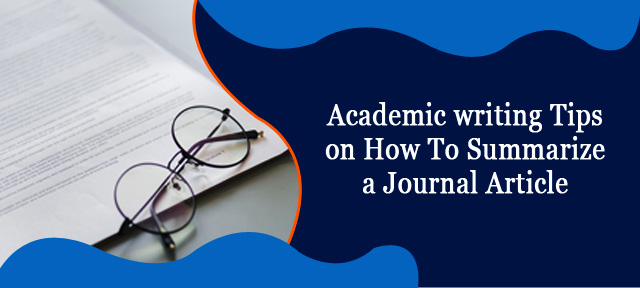Summarizing a journal article is a requirement for various activities; a researcher may have to summarize their own articles for research grants, as a reviewer you may have to summarize an article to give feedback. More often than not, young scholars have to summarize articles either as part of their curriculum or for senior researchers or supervisors for certain projects. Summarizing articles is an important part of academic writing and requires as much skill and discipline as any other form of writing.

Here are some tips on how to summarize a journal article.
How long: You first need to set how long your summary will have to be. It is quite understandable that the summary must be compact and way less than the original article, but at the same time must capture all the essence of the article. This is why it is important to first set before you the word limit for the summary. This may be pre-determined, for instance, if you are summarizing an article as part of the coursework the word limits and other details may be dictated as part of the assignment.
Understanding the type of article: You first need to understand what type of article you are summarizing and set the basic approach according to that. For argumentative articles, you need to focus on the basic theory being explored, the arguments cited for and against the theory, the theorization espoused by the author. For empirical articles, the research hypothesis, the methodology, the brief outline of the experimentations, the key findings, etc are the points that your summary needs to highlight.
Summarize, not review: There is a critical distinction between the literature review and article summary. In the latter, you are only stating the contents of the article in a gist. You are not reviewing it and thus there is no scope of value judgment, discussions on the content, contextualizing it to the field of existing literature. Everything in the summary must stem from the original content and not be your opinion.
Structure of the summary: Summaries are written in paragraph form and they are not supposed to have sections even if the original article does. The opening paragraph must be an introduction to the article, clearly stating the title, the name of the author(s), when and where it was published, etc. Each paragraph must report the key sections of the article as to what it states.
Highlights: The main purpose of the summary is to collate the highlights of the article in a crisper form. Read the abstract of the article to understand the basic core argument or objective of the article and design your summary in those lines. The keywords of the article are critical and must be properly reflected in your summary as part of the content. For empirical articles, the findings are the most obvious highlights that need to be duly reported in the summary.
Summarizing an article is an excellent exercise of getting clarity on the content and it will only help you in your academic pursuit.

